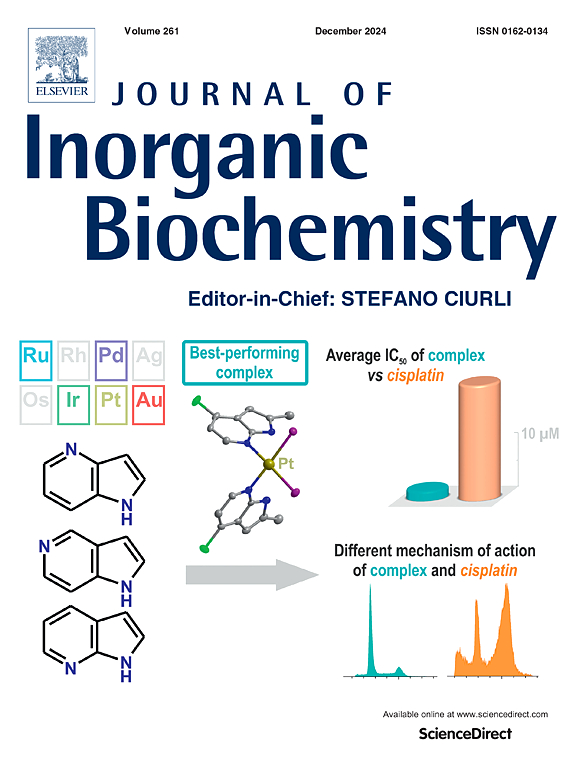抗坏血酸以Cu(II)介导的方式增强血浆中igg富集蛋白聚集体的形成
IF 3.2
2区 化学
Q2 BIOCHEMISTRY & MOLECULAR BIOLOGY
引用次数: 0
摘要
蛋白质聚集体在疾病中有报道,但在组织的生理环境中也有报道,血液中循环的蛋白质聚集体也有报道。游离Cu(II)诱导血清蛋白聚集,这种金属在与过氧化氢反应时产生高氧化物质,也与抗坏血酸(AA)反应。广泛的人群暴露于高剂量的AA作为二线治疗不同的病理或作为营养补充。本研究探讨了AA对血浆蛋白聚集体形成的影响,通过光密度、蛋白质定量和电泳(SDS-PAGE)观察到,与阻碍Cu(II)诱导的血浆蛋白聚集相反,AA增强了它们的形成。游离Cu(II)诱导形成富含IgG的血浆蛋白聚集体,但与AA的结合增强了γ -球蛋白(IgG)的结合,而其他蛋白质如白蛋白则被耗尽。用分离的IgG证实了Cu(II)和AA的增强作用。AA对Cu(II)诱导的蛋白质聚集的影响在分离的白蛋白中没有复制。此外,AA不会增强铁(III)介导的IgG、白蛋白或人血浆的聚集。最后,结果表明,在健康受试者静脉注射高剂量AA后,离心血浆中可获得抗氧化剂30 min后的聚集体。聚集的IgG已被证明可以激活Fc受体,参与中性粒细胞中观察到的氧化破裂和炎症过程。因此,AA对免疫系统的影响可能与富集特定蛋白质的蛋白质聚集体的积累有关。本文章由计算机程序翻译,如有差异,请以英文原文为准。

Ascorbic acid potentiates the formation of IgG-enriched protein aggregates in plasma in a Cu(II)-mediated manner
Protein aggregates have been reported in disease but also in physiological contexts in tissues as well as circulating protein aggregates in the bloodstream. Free Cu(II) induces the aggregation of serum proteins and this metal yields highly oxidant species upon reaction with hydrogen peroxide and also reacts with ascorbic acid (AA). A broad population is exposed to high doses of AA as second line therapy for different pathologies or as nutritional supplementation. This study addresses the effect of AA on the formation of plasma protein aggregates, observed by optic density, protein quantification and electrophoresis (SDS-PAGE) that, contrary to hampering the Cu(II)-induced plasma protein aggregation, AA potentiates their formation. Free Cu(II) induces the formation of IgG-enriched plasma protein aggregates but the combination with AA potentiates the incorporation of gamma-globulin (IgG) whereas other proteins such as albumin become depleted. The potentiating effect of Cu(II) and AA was corroborated employing isolated IgG. This effect of AA on Cu(II)-induced protein aggregation is not reproduced with isolated albumin. Additionally, AA does not potentiate Fe(III)-mediated aggregation of IgG, albumin or human plasma. Finally, it was shown that in healthy subjects which were administered high doses of intravenous AA, the aggregates can be obtained from the centrifuged plasma after 30 min of the administration of the antioxidant. Aggregated IgG have been shown to activate Fc receptors, involved in oxidative burst and inflammatory processes observed in neutrophils. Thus, the effect of AA on the immune system could be linked to the accumulation of protein aggregates enriched in specific proteins.
求助全文
通过发布文献求助,成功后即可免费获取论文全文。
去求助
来源期刊

Journal of Inorganic Biochemistry
生物-生化与分子生物学
CiteScore
7.00
自引率
10.30%
发文量
336
审稿时长
41 days
期刊介绍:
The Journal of Inorganic Biochemistry is an established international forum for research in all aspects of Biological Inorganic Chemistry. Original papers of a high scientific level are published in the form of Articles (full length papers), Short Communications, Focused Reviews and Bioinorganic Methods. Topics include: the chemistry, structure and function of metalloenzymes; the interaction of inorganic ions and molecules with proteins and nucleic acids; the synthesis and properties of coordination complexes of biological interest including both structural and functional model systems; the function of metal- containing systems in the regulation of gene expression; the role of metals in medicine; the application of spectroscopic methods to determine the structure of metallobiomolecules; the preparation and characterization of metal-based biomaterials; and related systems. The emphasis of the Journal is on the structure and mechanism of action of metallobiomolecules.
 求助内容:
求助内容: 应助结果提醒方式:
应助结果提醒方式:


